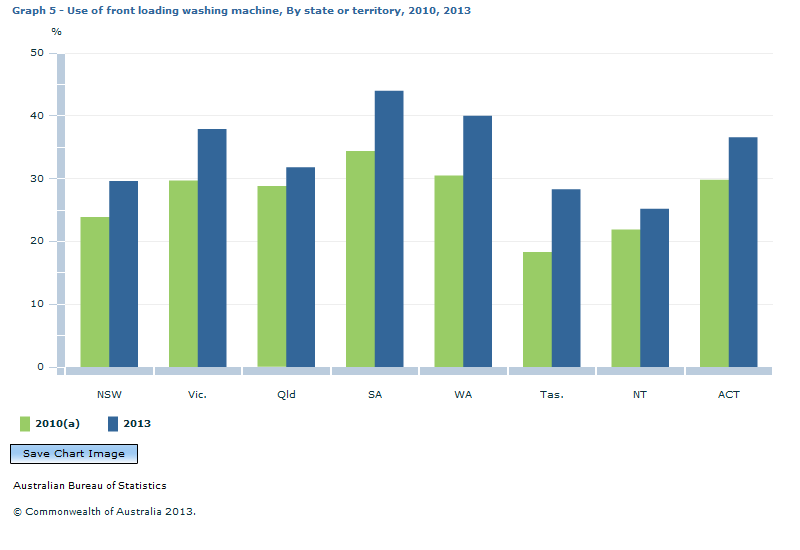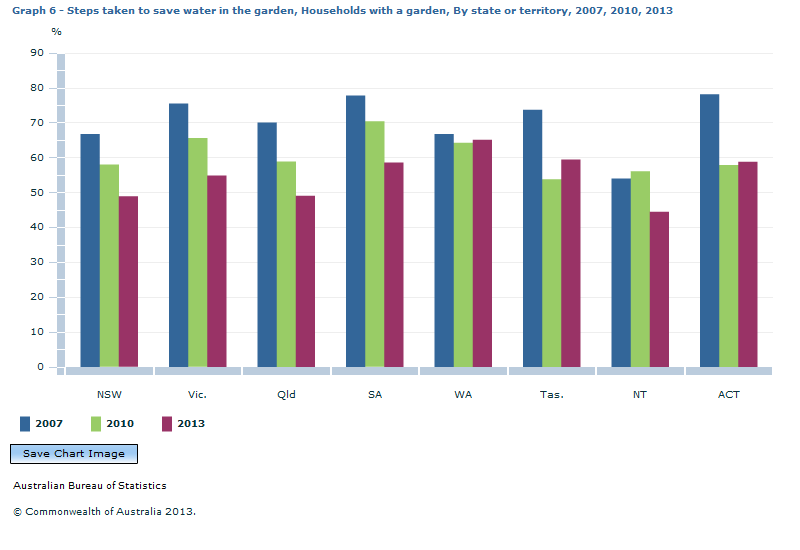4602.0.55.003 - Environmental Issues: Water use and Conservation, Mar 2013  Quality Declaration
Quality Declaration
ARCHIVED ISSUE Released at 11:30 AM (CANBERRA TIME) 30/10/2013
Page tools:
 Print Page Print Page
 Print All Print All
| ||
Accurate information on past, current and future water resources, supplies, demand and conservation behaviours are critical for effective urban and rural water planning activities. Understanding households' water usage and conservation behaviours has become increasingly important in past years due to the prevalence of drought conditions and the consequential water restrictions in many parts of Australia. As drought conditions have recently eased in most areas, Australians have continued to conserve water by adopting water saving practices and installing water saving devices and products. Increased water efficiency and conservation measures by Australian households may lessen the demand for fresh water supplies in urban and rural areas; resulting in greater environmental benefits and a sustainable water supply in the future. The efficient use of water and the use of water saving products both inside and outside the home can assist in reducing household water consumption. The use of front loading washing machines, generally more water efficient than top loaders, has increased over the last three years. Over 34% of Australian households had a front loading washing machine in 2013 compared with 28% in 2010. The proportion of households with a front loading washing machine has increased significantly in nearly all states and territories over the last three years. (Tables 15 and 16 and Graph 5)  Footnote(s): (a) Includes combination washer/dryer Approximately 62% of Australian households have only water efficient shower heads at their dwelling compared with 26% that have only regular shower heads. Households living in dwellings built within the last five years are more likely to have only water efficient shower heads (75%) compared with dwellings aged over five years. (Table 15) The majority of Australian households (79%) took at least one step to save water inside or outside their home in the last 12 months. Family households were more likely to have taken at least one step to save water inside or outside their home (80%) compared with lone person households (74%) and group households (70%). Of those households with a garden, family households were also more likely to have taken steps to save water in the garden (55%) compared with lone person households (50%) and group households (42%). (Table 17) Of the 4.3 million households that took at least one step to save water in the laundry, using the washing machine when fully loaded was a common step taken (54%), followed by adjusting the water level when washing (24%). Of the 4.5 million households that saved water in the bathroom, taking shorter showers was a common step taken (64%), followed by turning off the tap while cleaning teeth or shaving (45%). Of the 3.4 million households that saved water in the toilet, using the half flush on a dual flush toilet was a common step taken (66%), followed by flushing less often or only when needed (29%). (Table 19) Of the 3.9 million households that saved water in the garden, using mulch was a common step taken (42%), followed by only watering when necessary (34%) and watering at cooler times of the day (29%). Of the four million households that saved water outside the home, not including the garden, using a commercial car washing facility, was a common step taken (33%), followed by washing the car less often or not washing the car (29%). (Table 19) Of the 7.3 million households with a garden, the proportion of households that took at least one step to save water in the garden has decreased over the last six years, with 54% taking at least one step in 2013 compared with 62% in 2010 and 71% in 2007. A similar change in behaviour is apparent for most states and territories over the last six years with less households taking steps to save water in Victoria (55% in 2013 and 75% in 2007), Queensland (49% in 2013 and 70% in 2007) and South Australia (59% in 2013 and 78% in 2007). In contrast, the proportion of households that took at least one step to save water in the garden remained steady over the last six years in Western Australia (65% in 2013 and 67% in 2007). (Table 20 and Graph 6)  A variety of methods can be used for watering the garden and often more than one different watering method is used by a household. Nationally, relying on rainfall or not watering was reported by 36% of households with a garden as one of the methods they used to water their garden. This was a popular choice of behaviour for households living in Queensland (51%), though less common for households living in Western Australia (9%). Hand watering with a trigger hose (34%) and hand watering with a normal hose (22%) were also popular methods used by Australian households to water the garden. (Table 21) Document Selection These documents will be presented in a new window.
|
||
